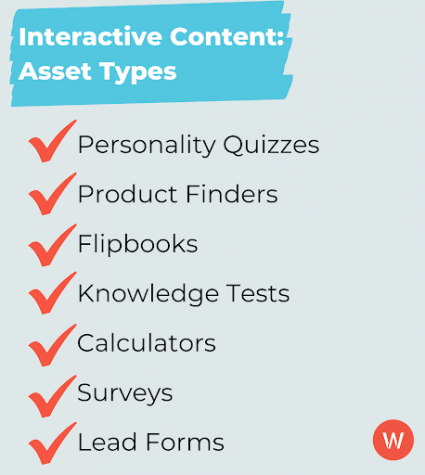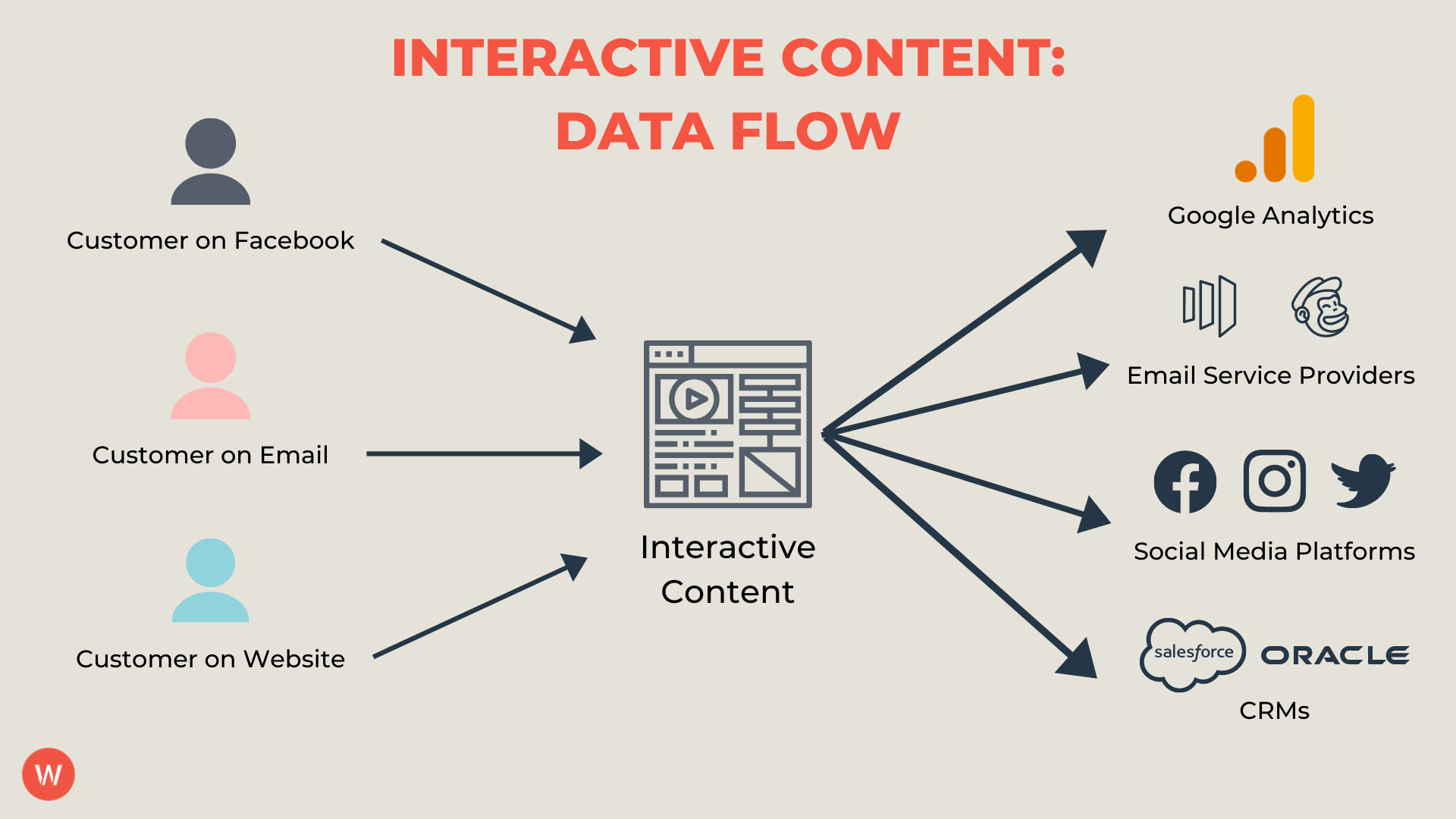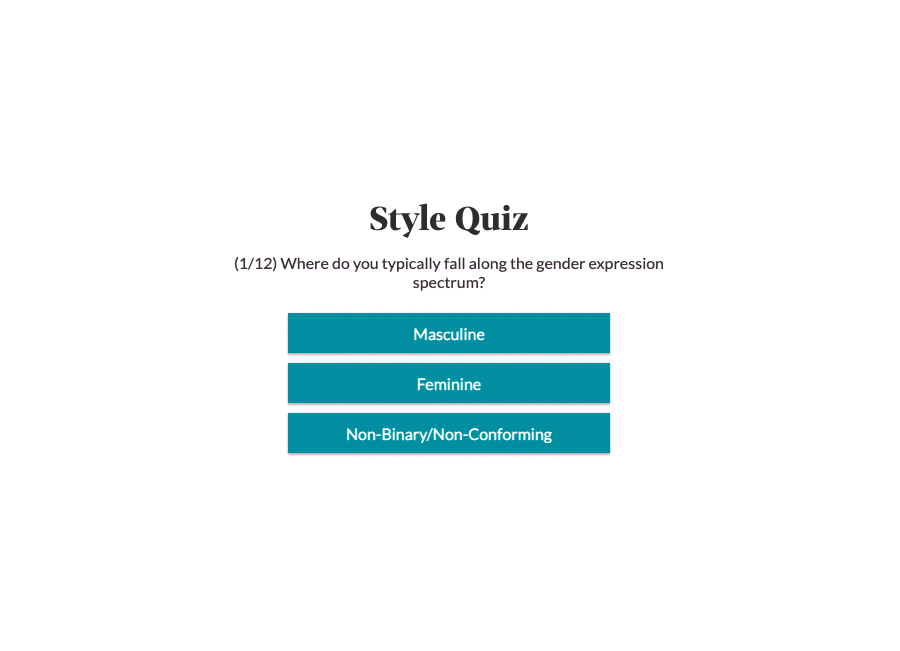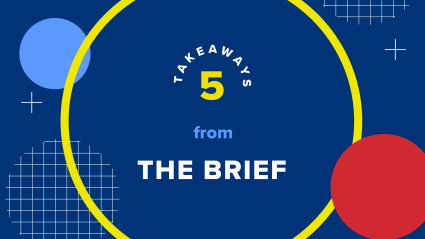The challenges brought on by GDPR, CCPA, and the impending “cookiepocalypse” are forcing brands to rethink their use and collection of first-party data.
Marketing teams need to prioritize collecting first-party data at every stage of the customer journey, not just at the purchase stage. And there’s nothing more powerful than interactive content to drive not just a great customer experience, but a strong data collection strategy—if it’s done right.
What is interactive content?
In its simplest form, interactive content refers to any type of content that requires viewers to actively engage with it. Rather than being static, text-heavy, or built for passive consumption, interactive content motivates viewers to become an integral part of a dynamic two-way experience through clicks, taps, or swipe-throughs.
What are the different types of interactive assets?

Here are the seven most common types of interactive content that drive customer engagement. The names may differ depending on the platform you’re using, but the concepts are universal:
- Personality Quizzes: Arguably the most popular type of interactive content, these experiences help quiz takers explore their preferences on certain topics (e.g. favorite color, vacation destination, etc.). The quiz questions, results, and tone can be fun and playful, and are often a great way to humanize your brand, rather than pushing customers to convert or purchase.
- Product Finders: Also presented as a quiz, these experiences are designed to provide tailored product or service recommendations based on the quiz taker’s declared answers, and are situated lower in the funnel than personality quizzes.
- Flipbooks: Think of these as digital magazines or embedded slideshows. Also known as lookbooks, you can present a catalog of related content in a visually appealing way that takes up less real estate on your webpage. For B2B organizations, flipbooks are a highly effective tool to achieve greater customer interaction on a whitepaper.
- Knowledge Tests: It’s trivia time! These experiences test a website visitor’s knowledge. For low-scoring participants, the outcome of the test will usually internally link to more upper-funnel content on your site to help educate them about particular topics. For high-scorers, the outcome might link to a product page or provide a discount code for a product or service related to the test.
- Calculators: These tools are often used to quantify data in a relevant way for the person interacting with it. An interactive calculator on a brand’s website can tabulate a question as simple as, “How old is my dog?” to more complex subjects like, “What’s my carbon footprint?” More often than not, calculators require custom coding due to their complexity.
- Surveys: Interactive surveys offer a more dynamic way of capturing feedback by taking advantage of at least 3 of the 5 senses: sight, sound, and touch. Whereas a traditional survey consists of a list of questions in a long form, an interactive survey involves questions that use a variety of tools that diversify the respondent’s experience by allowing them to answer questions in new and clever ways.
- Lead Forms: Similar to surveys, dynamic lead forms amplify engagement while allowing you to better understand and segment users based on their responses. These tools are great for B2Bs who might want to capture unique information for different prospects depending on their industry or vertical.
Getting started: how to create interactive content
There are many ways to create interactive content for your brand. Over the years, we’ve leveraged a variety of tools ranging from free website plug-ins to custom-coded interactive pieces for our clients.
One important lesson that we’ve learned along the way is that not all interactive tools are created equal, and limiting yourself to one solution likely won’t meet all of your expectations. The most important features to look for are functional practicality and ease of integration.
Some tools are extremely complex and require a developer to build and properly tag elements for data collection. These methods aren’t as practical for many marketers since they don’t allow for flexibility or quick, on-the-fly optimizations.
Other tools, and even custom-coded interactives, can fall flat when it comes to data collection and integration. If you don’t have a team member who is well-versed in data intelligence, you might run into problems gathering information and connecting the dots between data sources.

It’s crucial for your brand to leverage a solution that seamlessly integrates with Google Analytics as well as most major email service providers, social media platforms, and CRM platforms. When properly aligned, these integrations allow you to track user IDs and drill into hyper-specific ways new and existing customers respond to interactive content. With enough unique, first-party customer data, you’re able to better understand your target audiences, identify untapped markets, and further segment and personalize cross-channel remarketing efforts—especially important as data privacy restrictions tighten.
Checklist: How to amplify interactive content across the customer journey
With the right tools and amplification strategy, an interactive piece of content can collect thousands of data points in a short period of time. Make sure you follow these steps:
- Leverage social media channels with high engagement rates, such as Facebook and Instagram, to get your content in front of new audiences
- Post interactive content on organic social while integrating with an email nurture strategy to engage with existing audiences
- House the asset that links to your interactive content on relevant, organic, search optimized pages and blog posts
- Include your interactive experiences on-site link ad extensions for relevant paid search campaigns
Savvy marketers must be able to take gathered attributes and connect data points to better understand and build out their audience cohorts. This new cohort information can evolve existing amplification efforts by uncovering unique opportunities for future creative assets and retargeting methods.
The double-edged sword of first-party data collection
One important thing to note is that your amplification strategies can risk skewing data sets, so it’s critical to interpret your first-party data correctly. As you’re compiling huge amounts of customer data, remember that the whole is not always greater than the sum of its parts.
For example, perhaps the social ads that are driving traffic to your interactive quiz were set up to target 25- to 34-year-old metropolitan men, and the ad that generated the most conversions featured a green background. So your quiz might tell you that the majority of your prospective customers identify as men who are between the ages of 25 to 34, love the color green, and live in a big metropolitan city. As you can see, this data is problematic and doesn’t necessarily paint a complete picture of your full target audience—only a small piece of it.
Consider these nuances before you decide your data is telling the whole truth. Maybe you have enough attributes collected that can confidently speak to and understand your 25- to 34-year-old metropolitan male audience, but you may need to alter your targeting methods to gather more data on your female audiences.
Additionally, don’t discount data gathered from non-targeted audiences. Do your best to ensure your marketing tactics are inclusive, and you might be surprised at what you learn from untapped markets, which can help you discover innovative ways to communicate with new audiences that you may not have considered before.
Interactive content example: Zenni helps you find your perfect style
Zenni Optical, a pioneer of the online eyewear industry, leverages interactive content in cross-channel campaigns. Their interactive marketing efforts also span the funnel—from top-funnel personality quizzes for brand awareness and to learn about their audiences to bottom-funnel product finders to ensure customers make confident purchases.
One example is their new Style Shops campaign, which helps visitors find glasses that best match their unique aesthetic.

The idea for the quiz was born out of the diverse group of influencers Zenni was sourcing to take authentic photos for the campaign while wearing hand-picked glasses aligned with each person’s fashion sense.
Zenni amplified the quiz across social media, including Instagram and Pinterest, used it as a CTA in their emails, and featured it prominently on their Style Shops landing page. With first-party declared data from the quiz, Zenni can dig into the thousands of data points behind what makes someone boho vs. artsy or bold vs. classic and further tailor campaigns to each audience.
As you can see, it takes an integrated effort to maximize visibility and give interactive content the legs it deserves. A “set it and forget it” marketing strategy won’t allow for adequate data collection, and your investment will fall flat.







Responses